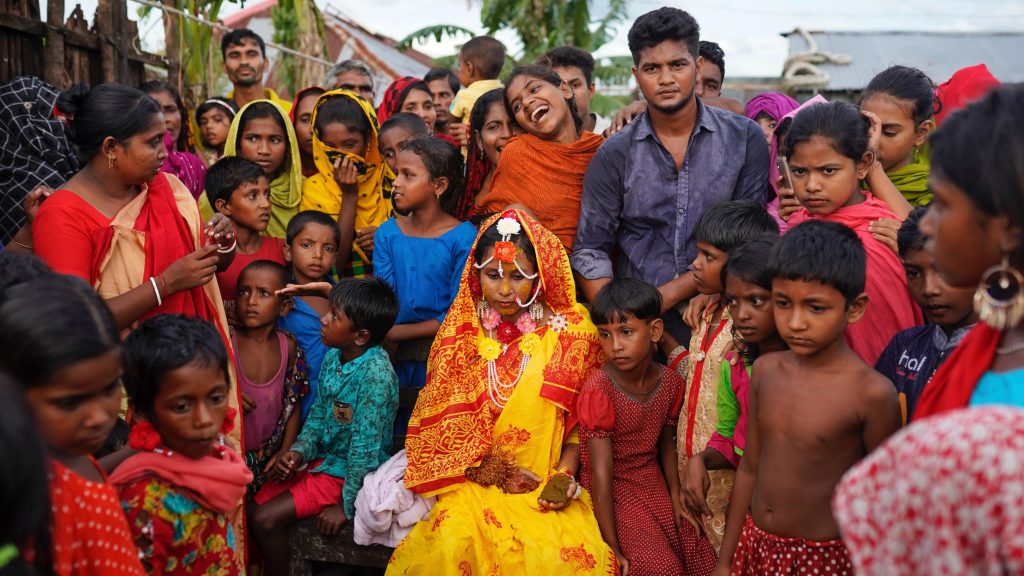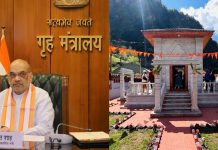We have to teach the parents how to make good use of the schemes for the girl child that have been put in place by governments so that they can educate their girls and they can be seen as an asset and not a liability
The Assam Government’s crackdown on child marriages is making headlines these days for obvious reasons. I don’t think that the country has ever seen anything like this and till now over 2500 people have been arrested and 4,074 FIRs lodged across the State.
The action came soon after the State Cabinet approved a proposal to book men who have married girls below 14 years of age under the Protection of Children from Sexual Offences (POCSO) Act. Cases under the Prohibition of Child Marriage Act, 2006 will be registered against those who have married girls in the 14-18 years’ age group. The offenders will be arrested and the marriages declared illegal. If the groom is below 14 years of age, he will be sent to a reform house.
The Government has vowed to keep the pressure up to end this malaise of child marriage and has justified this unprecedented action by citing figures, that quite honestly, are shocking.
According to Chief Minister Himanta Biswa Sarma, 17 per cent of over 6.2 lakh pregnant women in Assam last year were teenagers! Citing data from the Reproductive and Child Health (RCH) portal, Sarma said there were 6,20,867 registered pregnant women in 2022. Out of that 1,04,264 were 19 years or less, comprising 16.79 per cent of the expecting mothers. The undivided Dhubri district, including South Salmara, accounted for the highest 14,438 teenaged expecting mothers, followed by Nagaon with 12,188 pregnant teenagers and Barpeta with 11,658 teenaged moms to be. Other districts registering high teenage pregnancy in 2022 are Goalpara (6,250), Kamrup (4,773), Darrang (4,584), Morigaon (4,254) and Cachar (4,049).
Though the figures speak for themselves, the crackdown has faced criticism from the Opposition and legal experts alike for humanitarian reasons and there has been immense pushback and demonstrations at various places by the affected families in Barak Valley, Morigaon, Dhubri and Nagaon districts to name a few.
With the young men behind bars, their wives are left to fend for themselves and are running from pillar to post to find documents to prove they were not underage at the time of the marriage.
“Our menfolk have been taken away by the police, leaving us without anyone to look after us or to provide for us,” news agencies quoted Redshma Khatun as saying.
Some of the wives have been taken to Government shelters. “Those pregnant or with young children have been given priority to ensure they are taken care of. These facilities have limited resources. We are trying to make sure that women left alone and in need of help are given a place to stay till they can make proper alternative arrangements,” a staff member of a shelter home has been quoted as saying.
However, the State is determined to continue this drive until the objective of cracking down and discouraging child marriages in Assam is met.
Given the massive numbers, one can’t blame the Assam Government for wanting to crack down on child marriages. One only wishes that other States were as firm in their resolve to end this malaise, because the figures coming out of India are very alarming. Our country is estimated to have over 24 million child brides and according to the National Family Health Survey (NFHS) 40 per cent of the world’s 60 million child marriages take place here. India has the 14th highest rate of child marriage in the world, according to the International Center for Research on Women and as per the NFHS 2019-21. Nationally, 23.3 per cent women between the age group of 20-24 were married-off before attaining the age of 18.
Frighteningly, as per the NCRB-2021 report, at least 34 minor girls were kidnapped every day in 2021 to be compelled into marriage.
Worryingly, the conviction rate in child marriage cases stands at a paltry 10 per cent with at least 96 per cent such cases pending trial across the country by the end of 2021, says the Kailash Satyarthi Children’s Foundation.
But, despite all this, given the number of lives this crackdown has disrupted, the suffering it is causing to countless old parents, young wives, husbands and children, and the consequent human tragedy that is unfolding, there has to be another way of eradicating child marriage.
I am of the view that all Governments in the country will have to undertake mass campaigns to educate parents against the pitfalls of child marriage rather than use a coercive criminal law to deal with the malaise. We cannot ignore the human tragedy that unfolds due to knee-jerk reactions by the administrations, even as we cannot ignore the havoc that child marriages wreak on the boys and particularly girls forced into wedlock at an age when they should be in school, playing, studying, dreaming and preparing for a better future.
Because, make no mistake, that just like coercive Government action disrupts lives, so does child marriage. Trends show that while child marriage affects both, girls and boys, its impact on the health, education and human rights of girls is higher.
According to a report by UNICEF, “Child marriage robs girls of their childhood and threatens their lives and health. Girls who marry before 18 are more likely to experience domestic violence and less likely to remain in school. They have worse economic and health outcomes, than their unmarried peers, which are eventually passed down to their children. This further strains a country’s capacity to provide quality healthcare and education services. Child brides often become pregnant during adolescence, when the risk of complications and deaths during pregnancy and childbirth increases – for themselves and their infants. The practice can also isolate girls from family and friends and exclude them from participating in their communities, taking a heavy toll on their physical and psychological well-being.”
In yet another report on the impact of child marriage on boys, the UNICEF says, “Boys who marry before age 18 might enter into unions that involve experiences and responsibilities, including early fatherhood and providing for the household, for which they may lack adequate knowledge, resources, and psychosocial support. Most of the time the boys are unable to continue their education as they are forced to provide for a family they started even before they were ready for it.”
This obviously results in them having to give up their education and thus be caught in an endless cycle of poverty, despair and hopelessness, resulting in mental health issues and violence against the hapless wife and children.
So it’s a no brainer that India and other nations where the tradition of child marriage prevails have to stop this practice. But most of the time we end up treating the symptoms instead of looking for the root cause of the disease. The only way to eradicate child marriage is to first understand the underlying causes and then fight it with awareness, empowerment, education and of course the law.
In most cases it is poverty, lack of education about the laws of the land and its impact on the health and lives of the underage couple, the lack of resources and prevalence of the dowry system that leads to child marriage. But other than that, there are more deep-seated, complex factors at play which have to be understood in their entirety before we can even dream of rooting out this problem.

Child marriage in our country is also a result of rigid and regressive mindsets of a largely patriarchal society. It is about repressing the sexuality of girls. It is about fear for their safety in a society where crimes against women are spiralling at an alarming rate and where victim-shaming is a norm.
We have to try and understand why parents prefer boys over girls in spite of the numerous schemes and incentives given by the Centre and State Governments for the benefit of the girl child. Boys are preferred because they are expected to contribute to the family income and carry on the family name.
That’s why parents with limited resources educate their boys and not girls. And even if they do send their daughter to school, her education is the first casualty in financially tough times. Plus this mindset of not taking any contribution towards the family’s income from a girl is also largely to blame for parents considering a girl child’s education as a privilege rather than a right.
And the irony is that educated parents, with stable incomes in urban areas don’t mind so much taking help from their educated and earning daughters. It’s the poor, and uneducated with the least financial security and education that shun it. So till this section of society which thinks of a girl’s education as a privilege and not a right, doesn’t change its mindset, little girls will keep on paying for their parents’ ignorance and backwardness and the parents will continue to be mired in poverty.
Another significant and more disquieting reason for minor girls from underprivileged backgrounds in both urban and rural India being married off has to do with the concept of “purity” of a female. In a world consumed with girls’ innocence, the loss of the prized virginity in a male dominated society brings shame to a family. How much this “izzat (honour)” means in the subcontinent can be gauged from the number of honour killings that take place in the region.
So, parents of a girl are burdened with the task of having to protect her. And given the sad fact that a girl child is neither safe outside or within the home, the parents prefer to marry her off as soon as they can, so that they can be absolved of all responsibility of protecting her.
So unless we change our archaic mindsets and start treating boys and girls as equals, give them both equal educational opportunities so that girls, too, can pursue flourishing careers and provide for their parents in their old age, girls will continue to be married off at a tender age.
Until we don’t teach our males to respect females and put an end to sexual assaults and rapes, little girls will keep on paying the price and will be married off early.
In order to stop child marriages in India, we have to educate our girls, empower them with proper careers. We have to educate the parents through extensive awareness campaigns about the impact of child marriage on the health and lives of their wards, we have to teach them how to make good use of the schemes for the girl child that have been put in place by Governments so that they can educate their girls and help them get skills and careers so that they are seen as an asset and not a liability.
Apart from this we have to strengthen prevailing laws, enforce existing ones diligently. We as a society also need to do our bit and educate those who work for us in our homes against the pitfalls of child marriage. Then and only then, we will be able to slay this dragon of child marriage.












